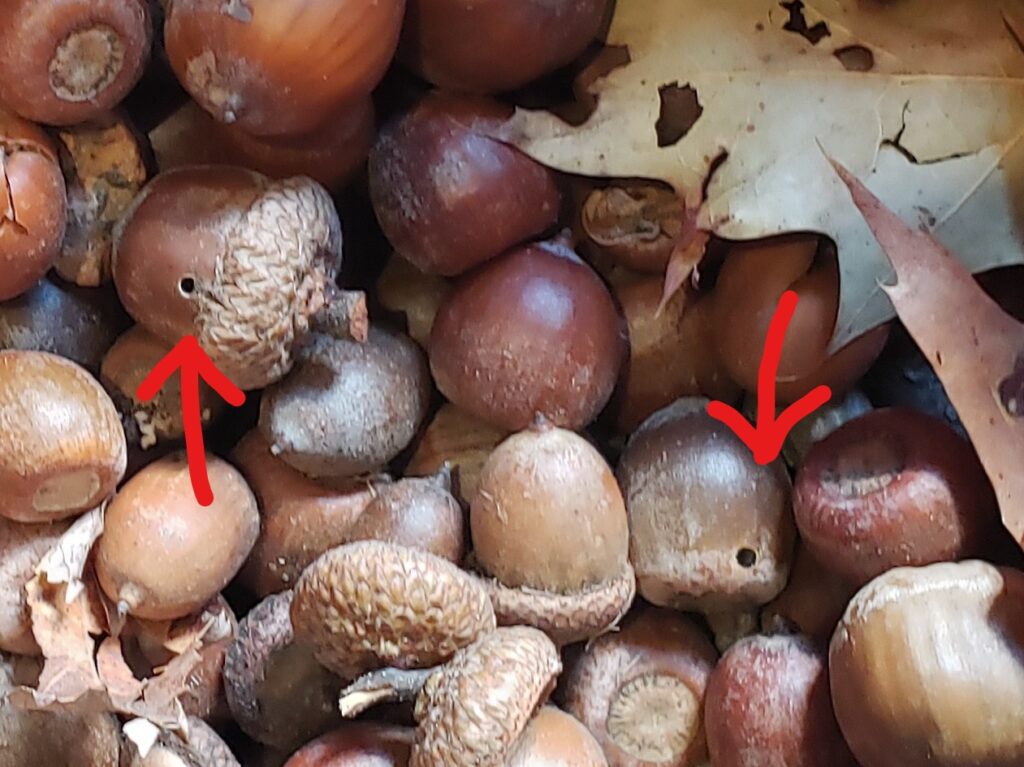Invasive plants are a major threat to Wisconsin’s forests, highlighted in the forest health chapter of Wisconsin’s Forest Action Plan. Invasive plants limit tree regeneration, reduce plant diversity and increase management costs. Recent Forest Inventory and Analysis data from the USDA Forest Service found that more than half of forest sites surveyed in Wisconsin had two or more invasive plant species. Forest landowners should learn to recognize common invasive plants like buckthorns, honeysuckles and garlic mustard. Mobile applications are a handy tool for landowners to learn to identify the plant species in their woods (e.g., PlantNet, iNaturalist) and report invasives (e.g., EDDMapS). For information about the regulated invasive plants in Wisconsin visit the Wisconsin Department of Natural Resources’ (DNR) Terrestrial Invasive Species page.
Forest Health News
Climate Impacts On Forest Insects
Climate change may impact forest insects in a variety of ways that will likely put stress on the forest. Warmer temperatures, altered precipitation patterns, more frequent extreme weather events and longer growing seasons are a few consequences of climate change that may shape the effects of insects in future forests. A changing climate may impact insects as:
- Warmer temperatures accelerate larval development and increase insect populations.
- Extended growing seasons allow for more generations of insects each year.
- Altered leaf chemistry modifies insect host plant preferences.
- Extreme weather events damage and stress forests, resulting in attacks by native and non-native insects.
- Warmer temperatures allow insects to expand their range and occupy new areas.
Many examples of insects responding to climate change have already been documented. Two examples are:
1) Mountain pine beetle expanding its geographic range in the western U.S. and infesting a new host tree species during the most recent outbreak; and
2) Eastern larch beetle having an additional generation each year that has resulted in an unprecedented 20-year outbreak in Minnesota. Continue reading “Climate Impacts On Forest Insects”
Statewide Forest Action Plan Strategies
Forest health experts from federal and state government, tribes and universities worked together to create the two goals and numerous strategies featured in the forest health chapter of Wisconsin’s 2020-2030 Statewide Forest Action Plan. Many goals and strategies in other chapters are also relevant to forest health efforts.
These goals are high-level statements about the desired future conditions of Wisconsin forests. The forest health chapter goals are:
- Forested land and ecosystem functions are maximized, while losses due to forest health threats are minimized
- Forest health threats are identified and managed in a fashion that is adaptive and responsive to multiple values
Forest Health In The Statewide Forest Action Plan
The forest health chapter of Wisconsin’s 2020-2030 Statewide Forest Action Plan, completed in June 2020, highlights the impacts of insects, diseases, invasive plants and worms in Wisconsin’s forests.
Forest health experts from government agencies, universities and tribes worked together to evaluate these current impacts. They then developed goals and strategies to help the forestry community refine how it will invest state, federal and partner resources to address major forest health management and landscape priorities over the next ten years.
Forest health is a critical component of the plan because native and non-native pests increase tree mortality to a level that negatively affects forest stocking levels, clean water, wildlife habitat and raw material for wood products. This causes economic losses and undesirable management outcomes. Continue reading “Forest Health In The Statewide Forest Action Plan”
Acorn Weevils Make Acorns Float
Article By: Linda Williams, DNR Forest Health Specialist, Woodruff
Linda.Williams@wisconsin.gov or 920-360-0665
Have you seen small round holes in acorns? These holes are a sign of acorn weevil damage that can occur in all Wisconsin oak species.
Got Buckthorn?
Article By: Jaqi Christopher, DNR Forest Invasive Plant Specialist, Rhinelander, Jacquelyn.Christopher@wisconsin.gov
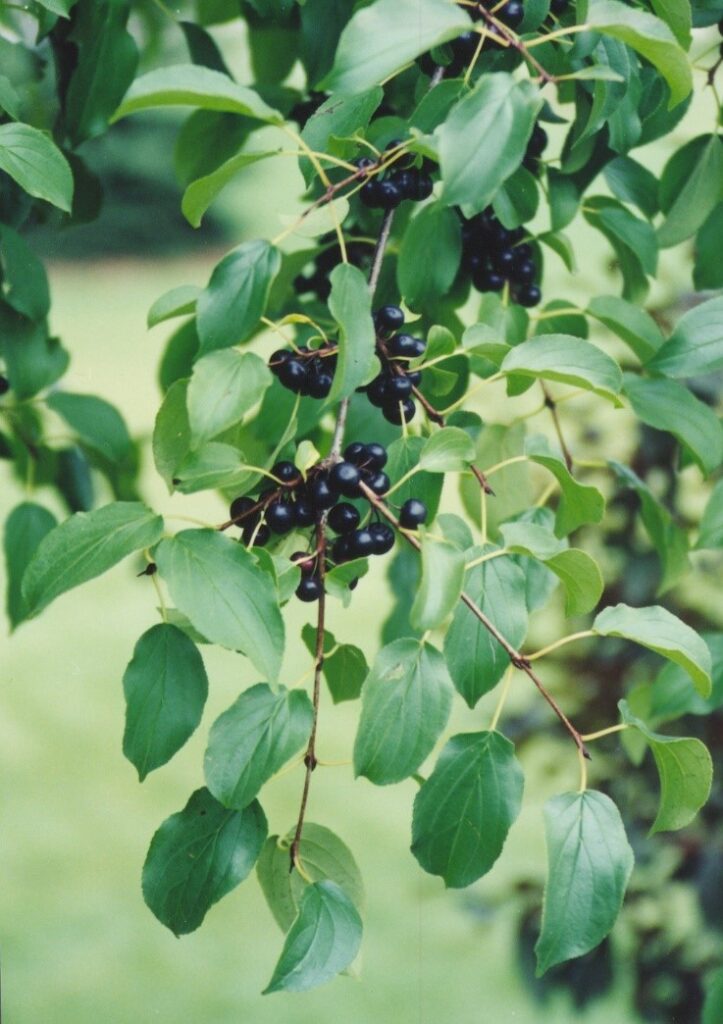
Common Buckthorn leaves with berries. Notice the prominent leaf veins and small thorns at the end of the branches.
Photo Credit: Wisconsin DNR
You can find buckthorn just about anywhere these days. It can sneak into the tidiest of gardens, as well as woodlots and forests. It aggressively outcompetes native plants and even tricks wildlife into spreading it to new areas. For example, birds are enticed to eat the berries, but buckthorn berries have a laxative effect, robbing birds of nutrition and ensuring the seeds are spread quickly across the landscape.
There are two species of buckthorn in the state: common buckthorn and glossy buckthorn. The plants are similar in appearance and equally harmful to native ecosystems. Common buckthorn and glossy buckthorn grow to be 20-25 feet tall. Glossy buckthorn has round, glossy leaves with prominent leaf veins and a smooth margin, while common buckthorn has dull green leaves with small teeth on the margin. The branches of common buckthorn will have a small thorn at the tip of the twig. The bark is similar in both species, being rough and flakey. Native cherry and plum trees have similar bark, but buckthorn can be identified by leaf appearance andby cutting into the bark to expose the bright yellow and orange wood underneath.
Take Action! Look For Gypsy Moth Egg Masses
Article By: Bill McNee, DNR Forest Health Specialist, Oshkosh
bill.mcnee@wisconsin.gov or 920-360-0942
In 2021, gypsy moth populations increased for a second consecutive summer due to favorable weather conditions. Populations typically increase with an average or mild winter, below average spring precipitation and above average May through June temperatures.
Regional variation in weather can result in significant differences in populations. If weather conditions are favorable again in 2022, the most noticeable increase in caterpillar numbers would likely occur in southern counties, where conditions were driest during this past spring and summer.
Populations experience the fastest growth rate and are first noticed on:
- Dry sites with sandy soil and abundant oak
- Mowed lawns with preferred tree species (oak, crabapple, birch, etc.)
- Large oaks (bur, in particular) with rough bark, especially on or adjacent to mowed lawns
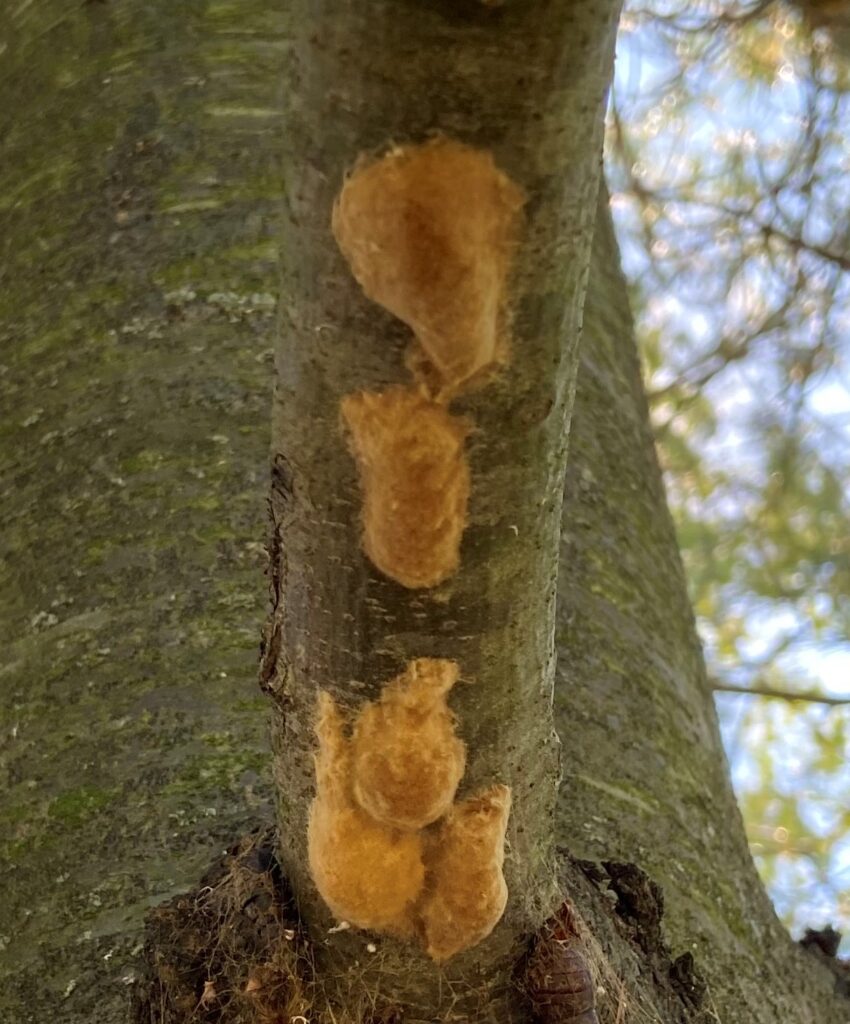
Gypsy moth egg masses found in Walworth County in fall 2021.
Photo Credit: Gypsy moth egg masses KMSU
Continue reading “Take Action! Look For Gypsy Moth Egg Masses”
Managing Damage By White Pine Weevil
Article By: Linda Williams, DNR Forest Health Specialist, Woodruff
Linda.Williams@wisconsin.gov or 920-360-0665
Tree damage from white pine weevil is noticeable across Wisconsin this time of year. White pine weevils attack several different Wisconsin species, including eastern white pine, jack pine and spruce.
Adult weevils lay their eggs on terminal leaders in the spring. After the eggs hatch, larvae bore into the terminal and begin feeding downwards just under the bark which can result in the killing of a 1 to 2-feet section of the terminal leader as they feed. Terminal leaders will often have a wilted or “shepherds crook” appearance, and they will turn rusty red to brown late in the fall season. These dead terminal leaders will often break off during the winter.
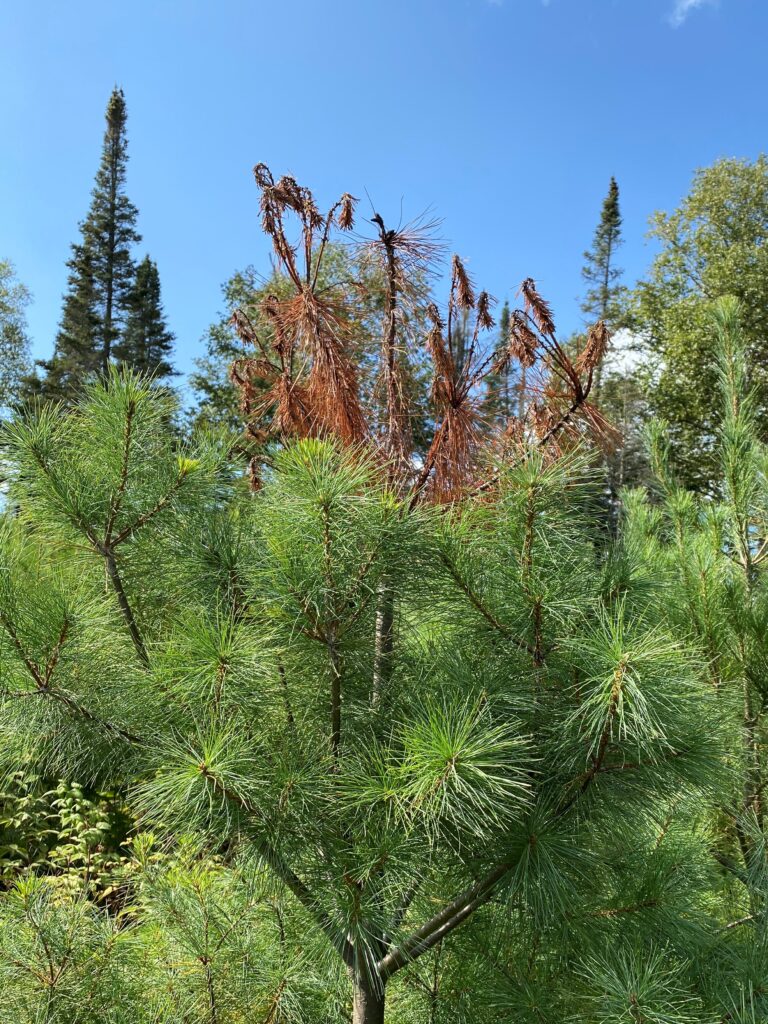
Dead terminal leader caused by a white pine weevil attack on a young white pine.
Photo Credit: Wisconsin DNR
Mystery Walnut Defoliator Identified
Article by: Mike Hillstrom, Forest Health Specialist
In 2020, forest health staff in Wisconsin, Minnesota and Iowa received calls about black walnut stands being defoliated and webbed. In 2021, the defoliation expanded to multiple additional black walnut stands in southwest Wisconsin, while northeast Iowa and Minnesota continued to see damage. Recently, molecular work completed by the Wisconsin Department of Agriculture, Trade and Consumer Protection has identified the larvae causing the damage as a native Tortricid moth, Gretchena amatana.
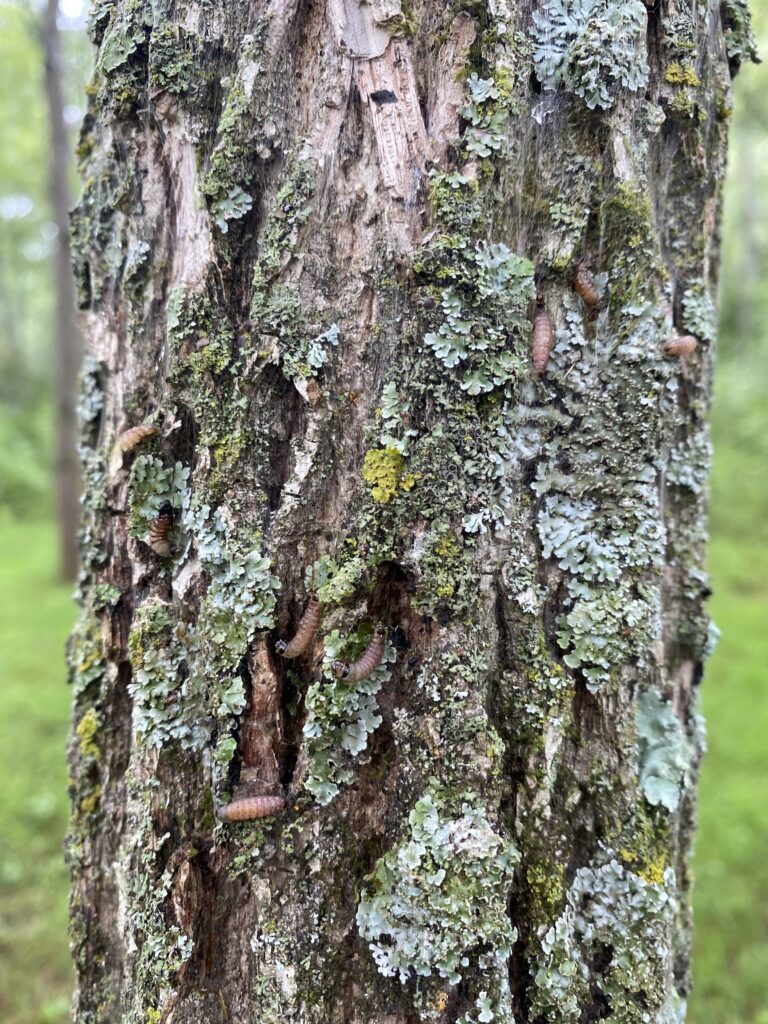
G. amatana caterpillars on tree.
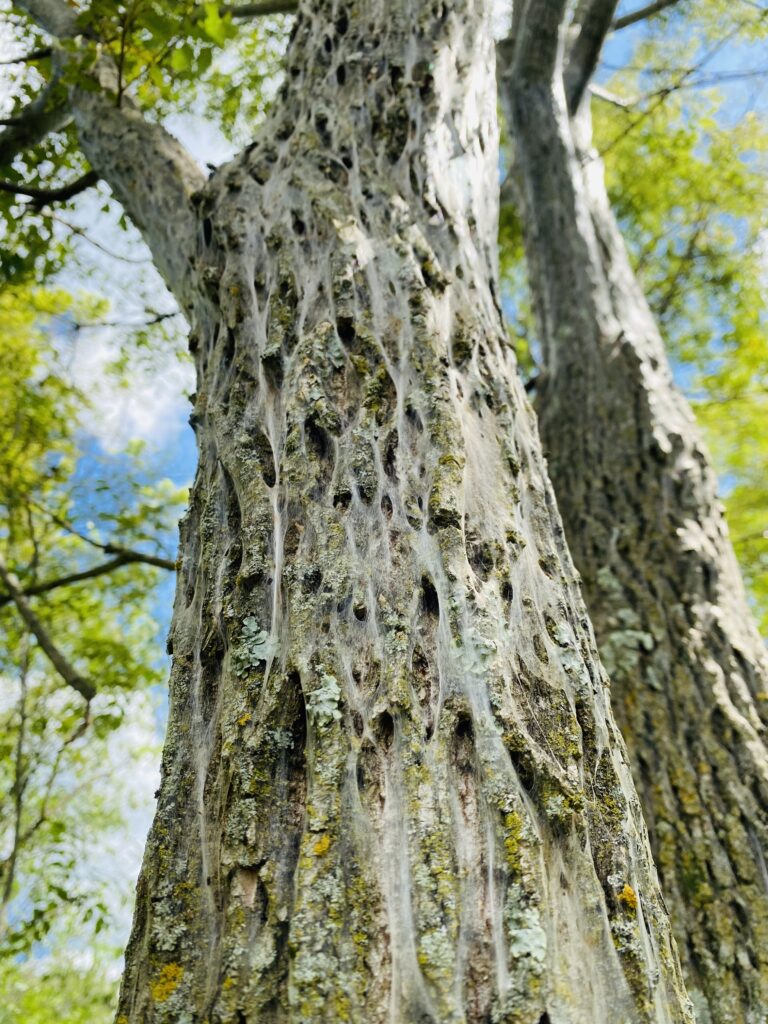
Fine webbing covers walnut tree trunk.
Young Oaks Defoliated By Oak Slug Sawfly
Article By: Linda Williams, DNR Forest Health Specialist, Woodruff
Linda.Williams@wisconsin.gov or 920-360-0665
The oak slug sawfly (Caliroa quercuscoccineae), sometimes called the scarlet oak sawfly, has the appearance of a small, slimy slug. Its slime helps it stick to leaves it feeds on. The oak slug sawfly’s tiny larvae feed in groups on the undersides of oak leaves, scraping out the green material from between the veins of the leaves. The upper leaf surface is usually left intact, creating a “stained glass window” look. Oak slug sawfly has the ability to completely defoliate leaves before dropping to the ground to pupate.
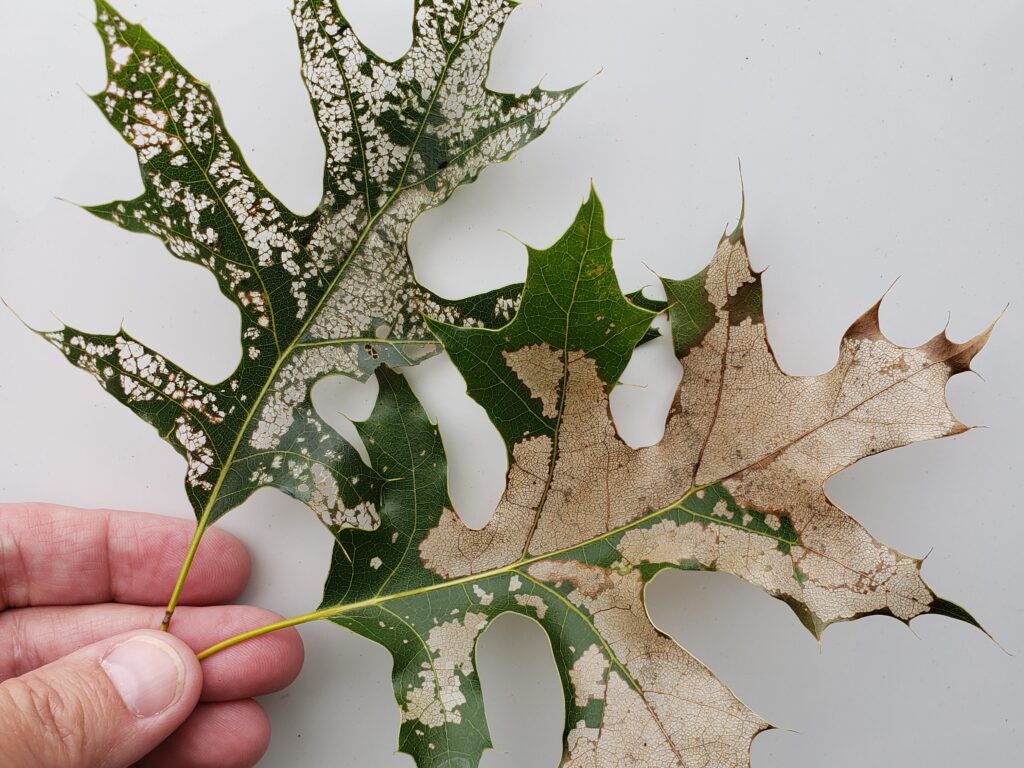
Oak slug sawfly larvae cause defoliation on oak leaf after feeding.
Photo Credit: Wisconsin DNR

